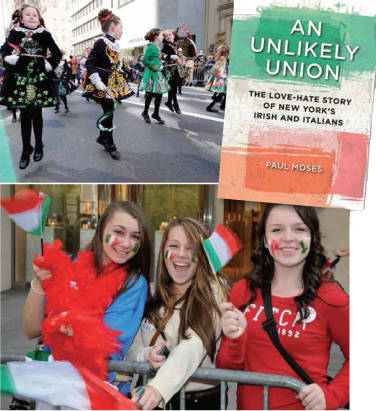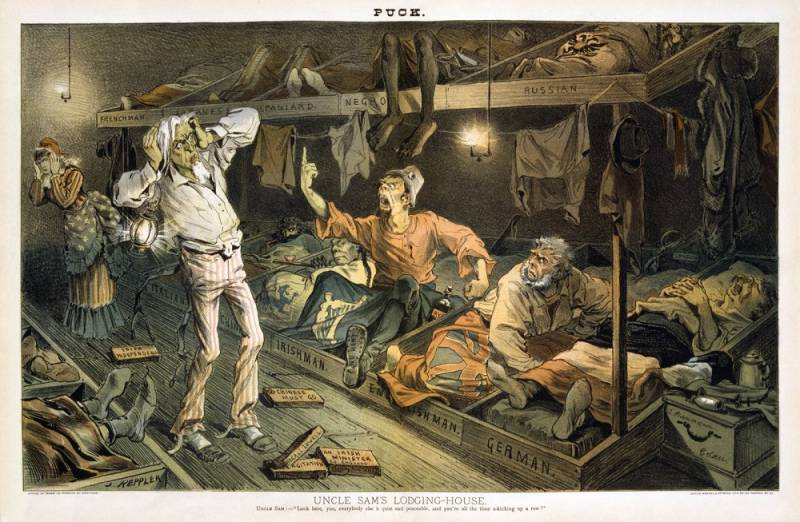The Irish-Italian Divide & How Enemies Make Peace
The idea for my book An Unlikely Union was spun from the yarn of everyday life: my wife Maureen’s ancestry is Irish, while mine is half Italian. It’s not remarkable, of course, but that’s the point.
Not so very long ago, the prospect of an Irish-Italian union such as ours might have stirred anger in our respective tribes, or at least gossip among the relatives. But by the time we walked down the aisle at St. Vincent de Paul Roman Catholic Church in Elmont, Long Island in 1976, that was no longer the usual case.
And yet, beginning in the nineteenth century and for decades into the twentieth, the Irish and Italians in New York and other major American cities were rivals in the Catholic Church, in the streets, on waterfront and construction job sites, in crime, the civil service and in politics. Then they fell in love with each other and married on a large scale in the years after World War II. What changed? That became a story I wanted to tell.
Peacemaking
I became intrigued by this Irish-Italian peace while working on another book about peacemaking, The Saint and the Sultan: The Crusades, Islam and Francis of Assisi’s Mission of Peace, published in 2009.
At the time, I had so immersed myself in Francis’s encounter with the sultan of Egypt during the Crusades that I would frequently dream at night that I was in the Middle Ages. As many authors will attest, a book project can produce an altered state of consciousness in which only the book seems to exist, much to the detriment of the writer’s relationship with his or her spouse. Basically, I wasn’t there for Maureen, even when I was sitting right in front of her.
While this caused some friction, the Irish-Italian peace in our household held up. Buried as I was in research about a Christian saint who reached out to Muslims, I began to see the arc of a historical story of peacemaking right in my own home—the journey of New York’s Irish and Italians from rumbles to romance.
A deep, bitter conflict
Through research in archived letters and newspapers, I found that the Irish-Italian conflict was deeper and more bitter than I had realized. For example, fights between Irish and Italian laborers were so common that the Brooklyn Eagle ran an editorial in 1894 asking “Can’t They Be Separated?” The paper urged contractors to “keep their gangs of workmen distinct—the Irish in one street and the Italians in another.”
Having arrived sooner than the Italians, the Irish were well established by the time the Italians began to migrate to the United States in large numbers in 1880. In the big picture, the Irish were moving up to better jobs as the Italians came in as underlings. But there were still plenty of Irish bootblacks, laborers, dockworkers and their union leaders who hated the Italians for their willingness to work longer hours for less pay. That often led to violence.
The Irish-Italian relationship was also complicated by the fact that they were two peoples divided by membership in the same church. Starting with churches such as Transfiguration on Mott Street in what is today Chinatown, parishes in New York and other major cities in the East and Midwest became battlegrounds for Irish-Italian conflict.
Angry disputes between Irish and Italian priests reached all the way to the Vatican as the Italians complained to Rome that they were only permitted to hold services in church basements. “Why only the basement? Forgive me, Excellency, if I tell you frankly that these poor devils are not very clean, so that the others do not want to have them in the upstairs church,” New York’s Archbishop Michael Corrigan wrote indelicately to a Vatican office that was reviewing the plight of Italian emigrants. “Otherwise the others move out, and then good-bye the income.”
Seeds for better times
But even in the midst of conflict, there were always seeds for better times. Irish labor leaders came to realize that they needed to unionize Italian workers, if only to present a united front against management. Archbishop Corrigan gave the Italians their own churches. Through the influence of its schools, the Catholic Church brought future generations of the Irish and Italians together and to the altar in marriage.
The Irish played the role of gatekeeper for the Italian immigrants, and were by turns mentor and tormentor. Eventually, the playing field leveled socially and economically. Love, marriage, babies and Italian Sunday dinners followed.
Working on the book was a humbling experience. I knew that Italians had occupied a low social rung, but saw through my research how routinely they were degraded and yet maintained their dignity and pride. Irish foremen may have been tough on Italian workers, but they were nowhere near as demeaning as the Anglo-Saxon intellectuals who claimed as a matter of science that Italians were racially inferior.
The only grandparents I knew were my father’s parents, a Jewish physician and his wife who fled from Hitler’s Germany. My mother’s parents, immigrants from Calabria and Basilicata, had died before I was born. Like Maureen’s Irish ancestors, they had come from extreme rural poverty to forge a new life. They lived in separate worlds: Little Italy and Brooklyn’s Irishtown.
But when two peoples mingle in their houses of worship, schools, neighborhoods, and workplaces, barriers can give way to collaboration and even love. That’s the story behind An Unlikely Union, which NYU Press will publish in June.
* Paul Moses is a professor of journalism at Brooklyn College/CUNY. Previously he worked for 23 years as a journalist in New York. In 1991 he won the Pulitzer Prize for Spot News Reporting. His book The Saint and the Sultan (Doubleday, 2009) won the 2010 Catholic Press Association award for best history book.



































Comments
online viagra
viagra cheap
cheap cialis online
cialis online
cialis
buy viagra online
buy viagra online
cheap viagra
cialis cheap
viagra cheap
cialis 20 mg en mexico
viagra
cheap viagra
cialis online
buy viagra online
viagra
cialis
generic viagra
cialis fast delivery
generic cialis
buy cialis online
buy viagra
cialis
uy viagra
viagra coupon
buy viagra online
buy cialis
viagra
buy cialis
buy cialis
cialis online
cheap cialis
buy cialis
viagra canada
discount viagra
canadian cialis
eneric cialis online
viagra generic
viagra online
viagra cheap
cheap viagra
online viagra
viagra online
buy generic cialis
buy viagra
Pages